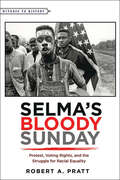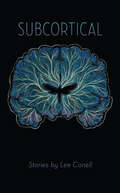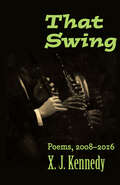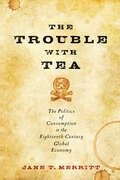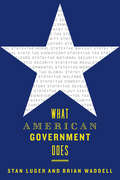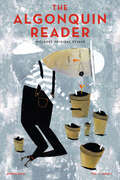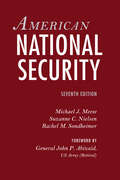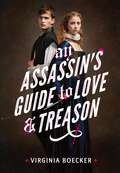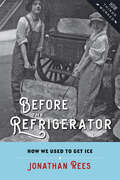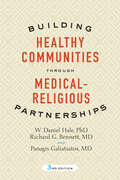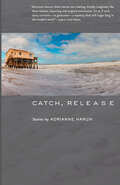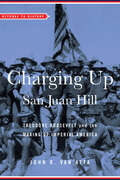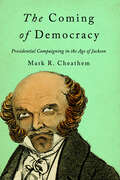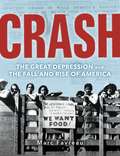- Table View
- List View
Selma;€™s Bloody Sunday: Protest, Voting Rights, and the Struggle for Racial Equality (Witness to History)
by Robert A. PrattOn Sunday afternoon, March 7, 1965, roughly six hundred peaceful demonstrators set out from Brown Chapel A.M.E. Church in a double-file column to march from Selma, Alabama, to the state capital of Montgomery. Leading the march were Hosea Williams of the Southern Christian Leadership Conference and John Lewis of the Student Nonviolent Coordinating Committee. Upon reaching Broad Street, the marchers turned left to cross the Edmund Pettus Bridge that spanned the Alabama River. "When we reached the crest of the bridge," recalls John Lewis, "I stopped dead still. So did Hosea. There, facing us at the bottom of the other side, stood a sea of blue-helmeted, blue-uniformed Alabama state troopers, line after line of them, dozens of battle-ready lawmen stretched from one side of U.S. Highway 80 to the other. Behind them were several dozen more armed men;¢;‚¬;€?Sheriff Clark;€™s posse;¢;‚¬;€?some on horseback, all wearing khaki clothing, many carrying clubs the size of baseball bats."The violence and horror that was about to unfold at the foot of the bridge would forever mark the day as "Bloody Sunday," one of the pivotal moments of the civil rights movement. Alabama state troopers fell on the unarmed protestors as they crossed the bridge, beating and tear gassing them. In Selma;€™s Bloody Sunday, Robert A. Pratt offers a vivid account of that infamous day and the indelible triumph of black and white protest over white resistance. He explores how the march itself;¢;‚¬;€?and the 1965 Voting Rights Act that followed;¢;‚¬;€?represented a reaffirmation of the nation;€™s centuries-old declaration of universal equality and the fulfillment of the Fifteenth Amendment to the Constitution.Selma;€™s Bloody Sunday offers a fresh interpretation of the ongoing struggle by African Americans to participate freely in America;€™s electoral democracy. Jumping forward to the present day, Pratt uses the march as a lens through which to examine disturbing recent debates concerning who should, and who should not, be allowed to vote. Drawing on archival materials, secondary sources, and eyewitness accounts of the brave men and women who marched, this gripping account offers a brief and nuanced narrative of this critical phase of the black freedom struggle.
Selma;€™s Bloody Sunday: Protest, Voting Rights, and the Struggle for Racial Equality (Witness to History)
by Robert A. PrattOn Sunday afternoon, March 7, 1965, roughly six hundred peaceful demonstrators set out from Brown Chapel A.M.E. Church in a double-file column to march from Selma, Alabama, to the state capital of Montgomery. Leading the march were Hosea Williams of the Southern Christian Leadership Conference and John Lewis of the Student Nonviolent Coordinating Committee. Upon reaching Broad Street, the marchers turned left to cross the Edmund Pettus Bridge that spanned the Alabama River. "When we reached the crest of the bridge," recalls John Lewis, "I stopped dead still. So did Hosea. There, facing us at the bottom of the other side, stood a sea of blue-helmeted, blue-uniformed Alabama state troopers, line after line of them, dozens of battle-ready lawmen stretched from one side of U.S. Highway 80 to the other. Behind them were several dozen more armed men;¢;‚¬;€?Sheriff Clark;€™s posse;¢;‚¬;€?some on horseback, all wearing khaki clothing, many carrying clubs the size of baseball bats."The violence and horror that was about to unfold at the foot of the bridge would forever mark the day as "Bloody Sunday," one of the pivotal moments of the civil rights movement. Alabama state troopers fell on the unarmed protestors as they crossed the bridge, beating and tear gassing them. In Selma;€™s Bloody Sunday, Robert A. Pratt offers a vivid account of that infamous day and the indelible triumph of black and white protest over white resistance. He explores how the march itself;¢;‚¬;€?and the 1965 Voting Rights Act that followed;¢;‚¬;€?represented a reaffirmation of the nation;€™s centuries-old declaration of universal equality and the fulfillment of the Fifteenth Amendment to the Constitution.Selma;€™s Bloody Sunday offers a fresh interpretation of the ongoing struggle by African Americans to participate freely in America;€™s electoral democracy. Jumping forward to the present day, Pratt uses the march as a lens through which to examine disturbing recent debates concerning who should, and who should not, be allowed to vote. Drawing on archival materials, secondary sources, and eyewitness accounts of the brave men and women who marched, this gripping account offers a brief and nuanced narrative of this critical phase of the black freedom struggle.
Subcortical (Johns Hopkins: Poetry and Fiction)
by Lee ConellRecipient of the 2018 Story Prize Spotlight AwardLee Conell;€™s linguistically deft stories examine the permeability between the real and the imagined, the stories buried beneath the surface and the stories by which we live our lives. In the title story of this collection, a young woman who wants to become a doctor is manipulated by an older man into playing a role in one of his medical studies. In "The Lock Factory," winner of the Chicago Tribune;€™s 2016 Nelson Algren Literary Award, three women who assemble school combination locks are trapped inside an escalating generational conflict of their own making. A boy who has lost his mother in "The Rent-Controlled Ghost" searches for the spirit of the mistreated tenant who formerly inhabited his apartment. "A Magic Trick for the Recently Unemployed" serves as a three-step how-to guide for reclaiming a sense of self and purpose. In "What the Blob Said to Me," an elderly woman dwells on her long-ago experience working at a government production site for the atomic bomb. And a mother-daughter Groupon for an upscale afternoon tea goes seriously awry in "Mutant at the Pierre Hotel."With humor and verve, Subcortical;€™s dynamic stories delve into the mysteries of the human mind as these haunted characters struggle with economic disparity, educational divides, and the often-contested spaces in which they live.
Subcortical (Johns Hopkins: Poetry and Fiction)
by Lee ConellRecipient of the 2018 Story Prize Spotlight AwardLee Conell;€™s linguistically deft stories examine the permeability between the real and the imagined, the stories buried beneath the surface and the stories by which we live our lives. In the title story of this collection, a young woman who wants to become a doctor is manipulated by an older man into playing a role in one of his medical studies. In "The Lock Factory," winner of the Chicago Tribune;€™s 2016 Nelson Algren Literary Award, three women who assemble school combination locks are trapped inside an escalating generational conflict of their own making. A boy who has lost his mother in "The Rent-Controlled Ghost" searches for the spirit of the mistreated tenant who formerly inhabited his apartment. "A Magic Trick for the Recently Unemployed" serves as a three-step how-to guide for reclaiming a sense of self and purpose. In "What the Blob Said to Me," an elderly woman dwells on her long-ago experience working at a government production site for the atomic bomb. And a mother-daughter Groupon for an upscale afternoon tea goes seriously awry in "Mutant at the Pierre Hotel."With humor and verve, Subcortical;€™s dynamic stories delve into the mysteries of the human mind as these haunted characters struggle with economic disparity, educational divides, and the often-contested spaces in which they live.
That Swing: Poems, 2008;€“2016 (Johns Hopkins: Poetry and Fiction)
by X. J. KennedyIn this, his ninth book of poetry, lyric master X. J. Kennedy regales his readers with engaging rhythm fittingly signaled by the book;€™s title, which echoes Duke Ellington;€™s jazz classic "It Don;€™t Mean a Thing (If It Ain;€™t Got That Swing)." Kennedy;€™s poems, infused with verve and surprise, are by turns irresistibly funny and sharply insightful about life in America.Some poems are personal recollections of childhood and growing up, as in "My Mother Consigns to the Flames My Trove of Comic Books." "Thomas Hardy;€™s Obsequies" tells the bizarre true account of the literary giant;€™s burial. Other poems portray memorable characters, from Jane Austen ("Jane Austen Drives to Alton in Her Donkey Trap") to a giant land tortoise ("Lonesome George") to a slow-witted man hired to cook for a nudist colony ("Pudge Wescott"). Kennedy is a storyteller of the first order, relating tales of travel to far-reaching places, from the Gal;¡pagos Islands and Tiananmen Square to the hectic back streets of Bamako, Mali. This wise and clever book is rounded out with adept translations of work by Charles Baudelaire, St;©phane Mallarm;©, Arthur Rimbaud, and others.
That Swing: Poems, 2008;€“2016 (Johns Hopkins: Poetry and Fiction)
by X. J. KennedyIn this, his ninth book of poetry, lyric master X. J. Kennedy regales his readers with engaging rhythm fittingly signaled by the book;€™s title, which echoes Duke Ellington;€™s jazz classic "It Don;€™t Mean a Thing (If It Ain;€™t Got That Swing)." Kennedy;€™s poems, infused with verve and surprise, are by turns irresistibly funny and sharply insightful about life in America.Some poems are personal recollections of childhood and growing up, as in "My Mother Consigns to the Flames My Trove of Comic Books." "Thomas Hardy;€™s Obsequies" tells the bizarre true account of the literary giant;€™s burial. Other poems portray memorable characters, from Jane Austen ("Jane Austen Drives to Alton in Her Donkey Trap") to a giant land tortoise ("Lonesome George") to a slow-witted man hired to cook for a nudist colony ("Pudge Wescott"). Kennedy is a storyteller of the first order, relating tales of travel to far-reaching places, from the Gal;¡pagos Islands and Tiananmen Square to the hectic back streets of Bamako, Mali. This wise and clever book is rounded out with adept translations of work by Charles Baudelaire, St;©phane Mallarm;©, Arthur Rimbaud, and others.
The Trouble with Tea: The Politics of Consumption in the Eighteenth-Century Global Economy (Studies in Early American Economy and Society from the Library Company of Philadelphia)
by Jane T. MerrittAmericans imagined tea as central to their revolution. After years of colonial boycotts against the commodity, the Sons of Liberty kindled the fire of independence when they dumped tea in the Boston harbor in 1773. To reject tea as a consumer item and symbol of "taxation without representation" was to reject Great Britain as master of the American economy and government. But tea played a longer and far more complicated role in American economic history than the events at Boston suggest.In The Trouble with Tea, historian Jane T. Merritt explores tea as a central component of eighteenth-century global trade and probes its connections to the politics of consumption. Arguing that tea caused trouble over the course of the eighteenth century in a number of different ways, Merritt traces the multifaceted impact of that luxury item on British imperial policy, colonial politics, and the financial structure of merchant companies. Merritt challenges the assumption among economic historians that consumer demand drove merchants to provide an ever-increasing supply of goods, thus sparking a consumer revolution in the early eighteenth century.The Trouble with Tea reveals a surprising truth: that concerns about the British political economy, coupled with the corporate machinations of the East India Company, brought an abundance of tea to Britain, causing the company to target North America as a potential market for surplus tea. American consumers only slowly habituated themselves to the beverage, aided by clever marketing and the availability of Caribbean sugar. Indeed, the "revolution" in consumer activity that followed came not from a proliferation of goods, but because the meaning of these goods changed. By the 1750s, British subjects at home and in America increasingly purchased and consumed tea on a daily basis; once thought a luxury, tea had become a necessity. This fascinating look at the unpredictable path of a single commodity will change the way readers look at both tea and the emergence of America.
The Trouble with Tea: The Politics of Consumption in the Eighteenth-Century Global Economy (Studies in Early American Economy and Society from the Library Company of Philadelphia)
by Jane T. MerrittAmericans imagined tea as central to their revolution. After years of colonial boycotts against the commodity, the Sons of Liberty kindled the fire of independence when they dumped tea in the Boston harbor in 1773. To reject tea as a consumer item and symbol of "taxation without representation" was to reject Great Britain as master of the American economy and government. But tea played a longer and far more complicated role in American economic history than the events at Boston suggest.In The Trouble with Tea, historian Jane T. Merritt explores tea as a central component of eighteenth-century global trade and probes its connections to the politics of consumption. Arguing that tea caused trouble over the course of the eighteenth century in a number of different ways, Merritt traces the multifaceted impact of that luxury item on British imperial policy, colonial politics, and the financial structure of merchant companies. Merritt challenges the assumption among economic historians that consumer demand drove merchants to provide an ever-increasing supply of goods, thus sparking a consumer revolution in the early eighteenth century.The Trouble with Tea reveals a surprising truth: that concerns about the British political economy, coupled with the corporate machinations of the East India Company, brought an abundance of tea to Britain, causing the company to target North America as a potential market for surplus tea. American consumers only slowly habituated themselves to the beverage, aided by clever marketing and the availability of Caribbean sugar. Indeed, the "revolution" in consumer activity that followed came not from a proliferation of goods, but because the meaning of these goods changed. By the 1750s, British subjects at home and in America increasingly purchased and consumed tea on a daily basis; once thought a luxury, tea had become a necessity. This fascinating look at the unpredictable path of a single commodity will change the way readers look at both tea and the emergence of America.
What American Government Does
by Stan Luger Brian WaddellIt has become all too easy to disparage the role of the US government today. Many Americans are influenced by a simplistic anti-government ideology that is itself driven by a desire to roll back the more democratically responsive aspects of public policy. But government has improved the lives of Americans in numerous ways, from providing income, food, education, housing, and healthcare support, to ensuring cleaner air, water, and food, to providing a vast infrastructure upon which economic growth depends. In What American Government Does, Stan Luger and Brian Waddell offer a practical understanding of the scope and function of American governance. They present a historical overview of the development of US governance that is rooted in the theoretical work of Charles Tilly, Karl Polanyi, and Michael Mann. Touching on everything from taxes, welfare, and national and domestic security to the government’s regulatory, developmental, and global responsibilities, each chapter covers a main function of American government and explains how it emerged and then evolved over time. Luger and Waddell are careful to both identify the controversies related to what government does and those areas of government that should elicit concern and vigilance. Analyzing the functions of the US government in terms of both a tug-of-war and a collaboration between state and societal forces, they provide a reading of American political development that dispels the myth of a weak, minimal, non-interventionist state.What American Government Does represents a major contribution to the scholarly debate on the nature of the American state and the exercise of power in America.
What American Government Does
by Stan Luger Brian WaddellIt has become all too easy to disparage the role of the US government today. Many Americans are influenced by a simplistic anti-government ideology that is itself driven by a desire to roll back the more democratically responsive aspects of public policy. But government has improved the lives of Americans in numerous ways, from providing income, food, education, housing, and healthcare support, to ensuring cleaner air, water, and food, to providing a vast infrastructure upon which economic growth depends. In What American Government Does, Stan Luger and Brian Waddell offer a practical understanding of the scope and function of American governance. They present a historical overview of the development of US governance that is rooted in the theoretical work of Charles Tilly, Karl Polanyi, and Michael Mann. Touching on everything from taxes, welfare, and national and domestic security to the government’s regulatory, developmental, and global responsibilities, each chapter covers a main function of American government and explains how it emerged and then evolved over time. Luger and Waddell are careful to both identify the controversies related to what government does and those areas of government that should elicit concern and vigilance. Analyzing the functions of the US government in terms of both a tug-of-war and a collaboration between state and societal forces, they provide a reading of American political development that dispels the myth of a weak, minimal, non-interventionist state.What American Government Does represents a major contribution to the scholarly debate on the nature of the American state and the exercise of power in America.
The Algonquin Reader: Spring 2018
by Algonquin Books of Chapel HillGet an inside look at Algonquin&’s outstanding forthcoming fiction with the Spring 2018 Algonquin Reader. Discover the inspiration behind each book through an original essay by the author. Then enjoy a short preview of each novel. The books featured in this issue are:The Optimistic Decade by Heather Abel On Sale May 2018Dreadful Young Ladies and Other Stories by Kelly Barnhill On Sale February 2018Lawn Boy by Jonathan Evison On Sale April 2018Remind Me Again What Happened by Joanna Luloff On Sale June 2018The Price of the Haircut: Stories by Brock Clarke On Sale March 2018Southernmost by Silas House On Sale June 2018 Cover illustration by Mark Hoffmann.
American National Security
by Michael J. Meese Suzanne C. Nielsen Rachel M. SondheimerAmerican National Security remains the ideal foundational text for courses in national security, foreign policy, and security studies. Every chapter in this edition has been extensively revised, and the book includes discussion of recent security policy changes in the Trump administration. Highlights include:;€¢ An updated look at national security threats, military operations, and homeland security challenges ;€¢ An analysis of the evolving roles of the president, Congress, the intelligence community, the military, and other institutions involved in national security;€¢ A revised consideration of the strengths, limitations, and employment of instruments of national power, including diplomacy, information, economic tools, and armed forces;€¢ An exploration of the economic and national security implications of globalization;€¢ An enhanced examination of the proliferation of transnational threats, including security challenges in space and in cyberspace;€¢ A new assessment of how international, political, and economic trends may change US leadership of the post;€“World War II international order;€¢ A comprehensive update on changing dynamics in key states and regions, including Russia, China, East Asia, the Middle East, South Asia, Europe, Sub-Saharan Africa, and Latin AmericaAn authoritative book that explains US national security policy, actors, and processes in a wide-ranging yet understandable way, American National Security addresses key issues, including challenges to the free and open international order, the reemergence of strategic competition among great powers, terrorism, economic and fiscal constraints, and rapid advances in information and technology.
An Assassin's Guide to Love and Treason
by Virginia BoeckerShakespeare in Love meets Mr. and Mrs. Smith in this witty and thrilling story of star-crossed assassins in Elizabeth England, perfect for fans of My Lady Jane and TheGentleman's Guide to Vice and Virtue! When Lady Katherine's father is killed for being an illegally practicing Catholic, she discovers treason wasn't the only secret he's been hiding: he was also involved in a murder plot against the reigning Queen Elizabeth I. With nothing left to lose, Katherine disguises herself as a boy and travels to London to fulfill her father's mission, and to take it one step further -- kill the queen herself. Katherine's opportunity comes in the form of William Shakespeare's newest play, which is to be performed in front of Her Majesty. But what she doesn't know is that the play is not just a play. It's a plot to root out insurrectionists and destroy the rebellion once and for all. The mastermind behind this ruse is Toby Ellis, a young spy for the queen with secrets of his own. When Toby and Katherine are cast opposite each other as the play's leads, they find themselves inexplicably drawn to one another. But the closer they grow, the more precarious their positions become. And soon they learn that star-crossed love, mistaken identity, and betrayal are far more dangerous off the stage than on.
Before the Refrigerator: How We Used to Get Ice (How Things Worked)
by Jonathan ReesDuring the late nineteenth and early twentieth centuries, Americans depended upon ice to stay cool and to keep their perishable foods fresh. Jonathan Rees tells the fascinating story of how people got ice before mechanical refrigeration came to the household. Drawing on newspapers, trade journals, and household advice books, Before the Refrigerator explains how Americans built a complex system to harvest, store, and transport ice to everyone who wanted it, even the very poor.Rees traces the evolution of the natural ice industry from its mechanization in the 1880s through its gradual collapse, which started after World War I. Meatpackers began experimenting with ice refrigeration to ship their products as early as the 1860s. Starting around 1890, large, bulky ice machines the size of small houses appeared on the scene, becoming an important source for the American ice supply. As ice machines shrunk, more people had access to better ice for a wide variety of purposes. By the early twentieth century, Rees writes, ice had become an essential tool for preserving perishable foods of all kinds, transforming what most people ate and drank every day. Reviewing all the inventions that made the ice industry possible and the way they worked together to prevent ice from melting, Rees demonstrates how technological systems can operate without a central controlling force. Before the Refrigerator is ideal for history of technology classes, food studies classes, or anyone interested in what daily life in the United States was like between 1880 and 1930.
Before the Refrigerator: How We Used to Get Ice (How Things Worked)
by Jonathan ReesDuring the late nineteenth and early twentieth centuries, Americans depended upon ice to stay cool and to keep their perishable foods fresh. Jonathan Rees tells the fascinating story of how people got ice before mechanical refrigeration came to the household. Drawing on newspapers, trade journals, and household advice books, Before the Refrigerator explains how Americans built a complex system to harvest, store, and transport ice to everyone who wanted it, even the very poor.Rees traces the evolution of the natural ice industry from its mechanization in the 1880s through its gradual collapse, which started after World War I. Meatpackers began experimenting with ice refrigeration to ship their products as early as the 1860s. Starting around 1890, large, bulky ice machines the size of small houses appeared on the scene, becoming an important source for the American ice supply. As ice machines shrunk, more people had access to better ice for a wide variety of purposes. By the early twentieth century, Rees writes, ice had become an essential tool for preserving perishable foods of all kinds, transforming what most people ate and drank every day. Reviewing all the inventions that made the ice industry possible and the way they worked together to prevent ice from melting, Rees demonstrates how technological systems can operate without a central controlling force. Before the Refrigerator is ideal for history of technology classes, food studies classes, or anyone interested in what daily life in the United States was like between 1880 and 1930.
Building Healthy Communities through Medical-Religious Partnerships
by W. Daniel Hale Richard G. Bennett Panagis GaliatsatosBecause health care works best when patients assume greater responsibility for their own health, community outreach and patient education are essential. But where can health care organizations find the resources to educate large numbers of people about chronic diseases? How can they tailor programs to meet the needs of increasingly diverse communities? And how can they reach people who have no ties to the health care system? Building Healthy Communities through Medical-Religious Partnerships presents an innovative approach to community-based health education and patient advocacy programs targeted at the prevention and management of disease. Offering valuable guidance for religious and medical leaders interested in developing programs in their congregations and communities, the book includes practical and accessible information for establishing health education programs, identifies additional resources that can be obtained from local and national organizations, and discusses a range of medical topics. It also outlines how to train volunteers to assist others in navigating our complex health system. This latest edition, which has been thoroughly revised and updated, incorporates;€¢ new chapters on medical topics across the lifespan, including lung disease, kidney disease, and child and adolescent health issues;;€¢ a thorough assessment of medical-religious partnerships that have emerged over the past twenty-five years; and;€¢ a user-friendly website with downloadable resources;¢;‚¬;€?including an instructor's guide, PowerPoint slides, and ready-made handouts.
Building Healthy Communities through Medical-Religious Partnerships
by W. Daniel Hale Richard G. Bennett Panagis GaliatsatosBecause health care works best when patients assume greater responsibility for their own health, community outreach and patient education are essential. But where can health care organizations find the resources to educate large numbers of people about chronic diseases? How can they tailor programs to meet the needs of increasingly diverse communities? And how can they reach people who have no ties to the health care system? Building Healthy Communities through Medical-Religious Partnerships presents an innovative approach to community-based health education and patient advocacy programs targeted at the prevention and management of disease. Offering valuable guidance for religious and medical leaders interested in developing programs in their congregations and communities, the book includes practical and accessible information for establishing health education programs, identifies additional resources that can be obtained from local and national organizations, and discusses a range of medical topics. It also outlines how to train volunteers to assist others in navigating our complex health system. This latest edition, which has been thoroughly revised and updated, incorporates;€¢ new chapters on medical topics across the lifespan, including lung disease, kidney disease, and child and adolescent health issues;;€¢ a thorough assessment of medical-religious partnerships that have emerged over the past twenty-five years; and;€¢ a user-friendly website with downloadable resources;¢;‚¬;€?including an instructor's guide, PowerPoint slides, and ready-made handouts.
Catch, Release: Stories (Johns Hopkins: Poetry and Fiction)
by Adrianne HarunIt;€™s all about loss. Don;€™t kid yourself. Even a simple game of catch is hinged on the moment the ball leaves the glove, the moment it returns. Don;€™t even try to think this story or any other story is about something else.In Catch, Release, Adrianne Harun;€™s second story collection, loss is the driver. But it;€™s less the usual somber shadow-figure of grieving than an erratically interesting cousin, unmoored, even exhilarated, by the sudden flight into emptiness, the freedom of being neither here nor there. In this suspended state, anything might happen;¢;‚¬;€?and it does. Harun;€™s most realistic stories are suffused with mystery, while her more fantastic tales reveal startling truths within the commonplace. In diverse settings that include, among other places, a British Columbian island, a haunted Midwestern farmhouse, a London townhome, and a dementia care facility overpopulated with dangerously idle guardian angels, characters reconfigure whole worlds as they navigate states defined by absence. In "The Farmhouse Wife," a young couple, struggling financially, takes up residence in a near-abandoned farmhouse, only to be joined by an inconvenient roommate, a woman whose own bereft state proves perilously seductive. A kleptomaniac father gets caught in one of his petty thefts in "Pearl Diving," propelling his two sons out of one life into another, perhaps more appropriate, one. In "Madame Ida," a family of little girls steadily invades a woman;€™s life as she puzzles out the mysteries of a missing sheriff-turned-cult-leader and the absence of her own son. And in the title story, two teenagers face off against the hurtful lies of an ancient con woman who is mining a widow;€™s grief for her own ends.Adrianne Harun has been described as an exacting and attentive stylist whose stories are rendered in vivid language. The Los Angeles Review of Books wrote of her work: "Harun finds beauty in pitch black; she makes poetry out of brutality and grace out of terror. She is an alchemist, turning the worst aspects of life into gold." With Catch, Release, Harun upends the world once more.
Catch, Release (Johns Hopkins: Poetry and Fiction)
by Adrianne HarunIt;€™s all about loss. Don;€™t kid yourself. Even a simple game of catch is hinged on the moment the ball leaves the glove, the moment it returns. Don;€™t even try to think this story or any other story is about something else.In Catch, Release, Adrianne Harun;€™s second story collection, loss is the driver. But it;€™s less the usual somber shadow-figure of grieving than an erratically interesting cousin, unmoored, even exhilarated, by the sudden flight into emptiness, the freedom of being neither here nor there. In this suspended state, anything might happen;¢;‚¬;€?and it does. Harun;€™s most realistic stories are suffused with mystery, while her more fantastic tales reveal startling truths within the commonplace. In diverse settings that include, among other places, a British Columbian island, a haunted Midwestern farmhouse, a London townhome, and a dementia care facility overpopulated with dangerously idle guardian angels, characters reconfigure whole worlds as they navigate states defined by absence. In "The Farmhouse Wife," a young couple, struggling financially, takes up residence in a near-abandoned farmhouse, only to be joined by an inconvenient roommate, a woman whose own bereft state proves perilously seductive. A kleptomaniac father gets caught in one of his petty thefts in "Pearl Diving," propelling his two sons out of one life into another, perhaps more appropriate, one. In "Madame Ida," a family of little girls steadily invades a woman;€™s life as she puzzles out the mysteries of a missing sheriff-turned-cult-leader and the absence of her own son. And in the title story, two teenagers face off against the hurtful lies of an ancient con woman who is mining a widow;€™s grief for her own ends.Adrianne Harun has been described as an exacting and attentive stylist whose stories are rendered in vivid language. The Los Angeles Review of Books wrote of her work: "Harun finds beauty in pitch black; she makes poetry out of brutality and grace out of terror. She is an alchemist, turning the worst aspects of life into gold." With Catch, Release, Harun upends the world once more.
Charging Up San Juan Hill: Theodore Roosevelt and the Making of Imperial America (Witness to History)
by John R. Van AttaBelow a Cuban sun so hot it stung their eyes, American troops hunkered low at the base of Kettle Hill. Spanish bullets zipped overhead, while enemy artillery shells landed all around them. Driving Spanish forces from the high ground would mean gaining control of Santiago, Cuba, and, soon enough, American victory in the Spanish-American War. No one doubted that enemy fire would claim a heavy toll, but these unusual citizen-soldiers and their unlikely commander;¢;‚¬;€?39-year-old Colonel Theodore Roosevelt;¢;‚¬;€?had volunteered for exactly this kind of mission.In Charging Up San Juan Hill, John R. Van Atta recounts that fateful day in 1898. Describing the battle;€™s background and its ramifications for Roosevelt, both personal and political, Van Atta explains how Roosevelt;€™s wartime experience prompted him to champion American involvement in world affairs. Tracking Roosevelt;€™s rise to the presidency, this book argues that the global expansion of American influence;¢;‚¬;€?indeed, the building of an empire outward from a strengthened core of shared values at home;¢;‚¬;€?connected to the broader question of cultural sustainability as much as it did to the increasing of trade, political power, and military might.At the turn of the twentieth century, Theodore Roosevelt personified American confidence. A New York City native and recovered asthmatic who spent his twenties in the wilds of the Dakota Territory, Roosevelt leapt into the war with Spain with gusto. He organized a band of cavalry volunteers he called the Rough Riders and, on July 1, 1898, took part in their charge up a Cuban hill the newspapers called San Juan, launching him to national prominence. Without San Juan, Van Atta argues, Roosevelt;¢;‚¬;€?whom the papers credited for the victory and lauded as a paragon of manhood;¢;‚¬;€?would never have reached a position to become president.
Charging Up San Juan Hill: Theodore Roosevelt and the Making of Imperial America (Witness to History)
by John R. Van AttaBelow a Cuban sun so hot it stung their eyes, American troops hunkered low at the base of Kettle Hill. Spanish bullets zipped overhead, while enemy artillery shells landed all around them. Driving Spanish forces from the high ground would mean gaining control of Santiago, Cuba, and, soon enough, American victory in the Spanish-American War. No one doubted that enemy fire would claim a heavy toll, but these unusual citizen-soldiers and their unlikely commander;¢;‚¬;€?39-year-old Colonel Theodore Roosevelt;¢;‚¬;€?had volunteered for exactly this kind of mission.In Charging Up San Juan Hill, John R. Van Atta recounts that fateful day in 1898. Describing the battle;€™s background and its ramifications for Roosevelt, both personal and political, Van Atta explains how Roosevelt;€™s wartime experience prompted him to champion American involvement in world affairs. Tracking Roosevelt;€™s rise to the presidency, this book argues that the global expansion of American influence;¢;‚¬;€?indeed, the building of an empire outward from a strengthened core of shared values at home;¢;‚¬;€?connected to the broader question of cultural sustainability as much as it did to the increasing of trade, political power, and military might.At the turn of the twentieth century, Theodore Roosevelt personified American confidence. A New York City native and recovered asthmatic who spent his twenties in the wilds of the Dakota Territory, Roosevelt leapt into the war with Spain with gusto. He organized a band of cavalry volunteers he called the Rough Riders and, on July 1, 1898, took part in their charge up a Cuban hill the newspapers called San Juan, launching him to national prominence. Without San Juan, Van Atta argues, Roosevelt;¢;‚¬;€?whom the papers credited for the victory and lauded as a paragon of manhood;¢;‚¬;€?would never have reached a position to become president.
The Coming of Democracy: Presidential Campaigning in the Age of Jackson
by Mark R. CheathemAfter the "corrupt bargain" that awarded John Quincy Adams the presidency in 1825, American politics underwent a fundamental shift from deference to participation. This changing tide eventually propelled Andrew Jackson into the White House;¢;‚¬;€?twice. But the presidential race that best demonstrated the extent of the changes was that of Martin Van Buren and war hero William Henry Harrison in 1840. Harrison;€™s campaign was famously marked by sloganeering and spirited rallies. In The Coming of Democracy, Mark R. Cheathem examines the evolution of presidential campaigning from 1824 to 1840. Addressing the roots of early republic cultural politics;¢;‚¬;€?from campaign biographies to songs, political cartoons, and public correspondence between candidates and voters;¢;‚¬;€?Cheathem asks the reader to consider why such informal political expressions increased so dramatically during the Jacksonian period. What sounded and looked like mere entertainment, he argues, held important political meaning. The extraordinary voter participation rate;¢;‚¬;€?over 80 percent;¢;‚¬;€?in the 1840 presidential election indicated that both substantive issues and cultural politics drew Americans into the presidential selection process.Drawing on period newspapers, diaries, memoirs, and public and private correspondence, The Coming of Democracy is the first book-length treatment to reveal how presidents and presidential candidates used both old and new forms of cultural politics to woo voters and win elections in the Jacksonian era. This book will appeal to anyone interested in US politics, the Jacksonian/antebellum era, or the presidency.
The Coming of Democracy: Presidential Campaigning in the Age of Jackson
by Mark R. CheathemAfter the "corrupt bargain" that awarded John Quincy Adams the presidency in 1825, American politics underwent a fundamental shift from deference to participation. This changing tide eventually propelled Andrew Jackson into the White House;¢;‚¬;€?twice. But the presidential race that best demonstrated the extent of the changes was that of Martin Van Buren and war hero William Henry Harrison in 1840. Harrison;€™s campaign was famously marked by sloganeering and spirited rallies. In The Coming of Democracy, Mark R. Cheathem examines the evolution of presidential campaigning from 1824 to 1840. Addressing the roots of early republic cultural politics;¢;‚¬;€?from campaign biographies to songs, political cartoons, and public correspondence between candidates and voters;¢;‚¬;€?Cheathem asks the reader to consider why such informal political expressions increased so dramatically during the Jacksonian period. What sounded and looked like mere entertainment, he argues, held important political meaning. The extraordinary voter participation rate;¢;‚¬;€?over 80 percent;¢;‚¬;€?in the 1840 presidential election indicated that both substantive issues and cultural politics drew Americans into the presidential selection process.Drawing on period newspapers, diaries, memoirs, and public and private correspondence, The Coming of Democracy is the first book-length treatment to reveal how presidents and presidential candidates used both old and new forms of cultural politics to woo voters and win elections in the Jacksonian era. This book will appeal to anyone interested in US politics, the Jacksonian/antebellum era, or the presidency.
Cook with Amber: Fun, Fresh Recipes to Get You in the Kitchen
by Amber Kelley"Amber's beautiful book is bursting with great ideas that make healthy eating a joy-and she's done a great job covering all the bases that, in my experience, teens and kids really want." -- Jamie Oliver Fifteen-year-old Amber Kelley is inspiring a whole new generation of eaters to get in the kitchen and have fun. She is the first winner of Food Network Star Kids, a member of celebrity chef Jamie Oliver's Food Tube family, and the host of her own web series on Foodnetwork.com and YouTube. Her work has been recognized by First Lady Michelle Obama, and Amber has been featured on national TV networks such as the Disney Channel, E!, and NBC's Today. Now, Amber's 80 most popular and delicious recipes have been hand-picked for her cookbook to empower teens to get in the kitchen. From nourishing breakfasts to start the day right, to school lunches to impress your friends, party ideas for every occasion, and even recipes for the best homemade facial scrubs to fight that dreaded teen acne, Amber shares her secrets for using the power of food to get the best out of her teen years. Includes 45 full-color photographs throughout.
Crash: The Great Depression and the Fall and Rise of America
by Marc FavreauThe incredible true story of how real people weathered one of the most turbulent periods in American history—the Great Depression—and emerged triumphant. From the sweeping consequences of the stock market crash to the riveting stories of individuals and communities caught up in a real American dystopia, discover how the country we live in today was built in response to a time when people from all walks of life fell victim to poverty, insecurity, and fear. Meet fascinating historical characters like Herbert Hoover, Franklin Delano and Eleanor Roosevelt, Frances Perkins, Dorothea Lange, Walter White, and Mary McLeod Bethune. See what life was like for regular Americans as the country went from the highs of the Roaring Twenties to the lows of the Great Depression, before bouncing back again during World War II. Explore pivotal scenes such as the creation of the New Deal, life in the Dust Bowl, the sit-down strikes in Michigan, the Scottsboro case, and the rise of Father Coughlin. Packed with photographs and firsthand accounts, and written with a keen understanding of the upheaval of the 1930s, Crash shares the incredible story of how America survived—and, ultimately, thrived.
